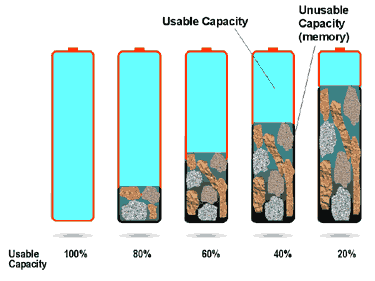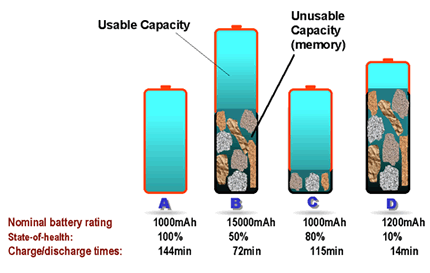<< Previous page INDEX Next page >>
11.1 The ‘Green Light’ Lies
When charging a battery, the ready light will eventually illuminate, indicating that the battery is fully charged. The user assumes that the battery has reached its full potential and the battery is taken in confidence.
In no way does the ‘green light’ guarantee sufficient battery capacity or assure good state-of-health (SoH). Similar to a toaster that pops up the bread when brown (or black), the charger fills the battery with energy and ‘pops’ it to ready when full (or warm).
The rechargeable battery is a corrosive device that gradually loses its ability to hold a charge. Many users in an organization are unaware that their fleet batteries barely last a day with no reserve energy to spare. In fact, weak batteries can hide comfortably because little demand is placed on them in a routine day. The situation changes when full performance is required during an emergency. Total collapse of portable systems is common and such breakdowns are frequently related to poor battery performance. Figure 11-1 shows five batteries in various states of degradation.
Figure 11-1: Progressive loss of charge acceptance.
The rechargeable battery is a corrosive device that gradually loses its ability to hold charge as part of natural aging, incorrect use and/or lack of maintenance. The unusable part of the battery that creeps in is referred to as ‘rock content’.Carrying larger packs or switching to higher energy-dense chemistries does not assure better reliability if the weak batteries are not ‘weeded’ out at the appropriate time. Likewise, the benefit of using ultra-advanced battery systems offers little advantage if packs are allowed to remain in the fleet once their performance has dropped below an acceptable performance level.
Figure 11-2 illustrates four batteries with different ratings and SoH conditions. Batteries B, C and D show reduced performance because of memory problems and other deficiencies. The worst pack is Battery D. Because of its low charge acceptance, this battery might switch to ready after only 14 minutes of charge (assumed time). Ironically, this battery is a likely candidate to be picked when a fresh battery is required in a hurry. Unfortunately, it will last only for a brief moment. Battery A, on the other hand, has the highest capacity and takes the longest to charge. Because the ready light is not yet lit, this battery is least likely picked.
Figure 11-2: Comparison of charge and discharge times.
This illustration shows typical charge and discharge times for batteries with different ratings and SoH conditions. Carrying larger batteries or switching to high energy-dense chemistries does not necessarily assure longer runtime if deadwood is allowed to remain in the battery fleet.
The weak batteries are charged quicker and remain on ‘ready’ longer than the strong ones. The bad batteries tend to gravitate to the top. They become a target for the unsuspecting user. In an emergency situation that demands quick charge action, the batteries that show ready may simply be those that are deadwood.
A weak battery can be compared to a fuel tank with an indentation. Refueling this tank is quicker than a normal tank because it holds less fuel. Similar to the ‘green light’ on a charger, the fuel gauge in the vehicle will show full when filled to the brim, but the distance traveled before refueling will be short.

